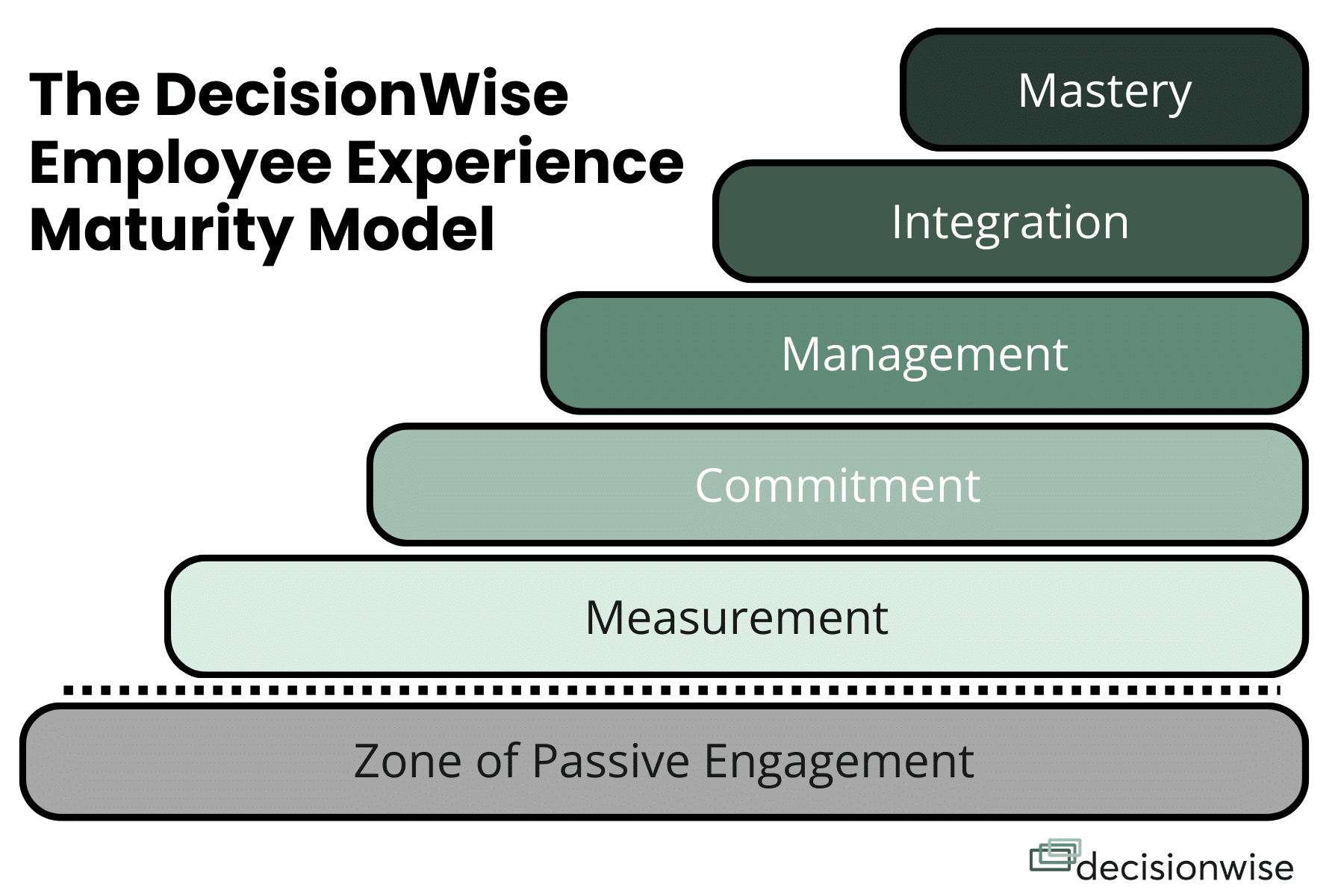The concept of the Circle of Influence was made popular in Stephen Covey’s best-selling book, 7 Habits of Highly Effective People, released in 1989. In the chapter describing the first habit, Be Proactive, he explains how people respond differently to factors that are in their Circle of Concern, Influence, and Control.
Many people tend to think of factors that are either within or outside their control. The Circle of Influence provides a third important alternative to help expand our impact, especially as it relates to employee engagement.
- Circle of Concern: Reactive people tend to get distracted by things that are outside their direct control, or Circle of Concern. These are things like the weather, a pandemic, or the economy.
- Circle of Influence: Proactive people focus their efforts on things they can potentially impact in their Circle of Influence. These are things like work procedures, perceptions of others, and the foods their children eat.
- Circle of Control: These are things that can be controlled directly like personal work performance, how managers schedule their employees, and the food we eat.
The idea is to spend more time focused on things in the Circles of Control and Influence and less time worried about the Circle of Concern. Additionally, by pulling some items over from the Circle of Concern into the Circle of Influence, we are likely to have a greater impact.
Locus of Control
Covey’s ideas expand on the concept of Locus of Control developed by American psychologist, Julian Rotter, in 1954. Rotter argued that those with an internal locus of control believe they have more power over the outcomes in their lives based on their decisions and actions. They view getting an A on a test a result of their hard work and study. People that have a strong sense of internal locus of control tend to be more proactive and focused on their circles of Control and Influence.
Those with an external locus of control feel that they are at the mercy of outside factors. They attribute failing a test to poor instruction from the teacher or bad test design. People with an external locus of control are more reactive and focused on their Circle of Concern (external factors).
Team Exercise to Reduce Stress and Increase Confidence
Managers can use this model of Control, Influence, and Concern with their teams to problem-solve and prioritize work. For example, if the team is experiencing high workload or navigating a complicated change, sorting their concerns into the three circles helps to reduce stress and increase confidence. The exercise involves having each team member write their ideas and concerns on separate sticky notes. After discussing each idea, the team decides together where to place the notes in each of the three circles: Control, Influence, and Concern.
This exercise’s purpose is to empower the team by helping them realize they have more control or influence over their concerns than previously thought. Maybe a concern is outside their control, but they discover new ways to influence it. Those on the team with a stronger internal locus of control can help those with an external locus of control see more possibilities. The act of identifying team concerns, describing them, and organizing them helps to decrease the stress these concerns cause and creates an actionable path forward.
A Manager’s Circle of Influence on Employee Engagement
DecisionWise research shows that managers have a strong influence, maybe the most important external influence, on their team’s engagement. In the largest study of its kind, we reviewed employee survey results from 22 companies comparing the engagement levels of 2,300 managers to the their team’s engagement (18,913 rank-and-file employees).
We first measured the overall level of engagement for each individual using a set of research-based anchor questions from their annual employee survey. We then grouped managers and employees according to their level of engagement into four categories: Fully Engaged, Key Contributors, Opportunity Group, and Fully Disengaged. Then we compared the engagement level of managers to the employees they lead.
- The first group shows the team profile for 808 Fully Engaged managers. We found that 36% of their employees were also Fully Engaged, 48% were Key Contributors, 12% were in the Opportunity Group, and only 3% were Fully Disengaged.
- For the second group of 1,154 Key Contributor managers, the level of fully engaged employees drops to 24%. That’s a 33% difference compared to the fully engaged managers.
- For the last two categories of Opportunity Group and Fully Disengaged managers, only 14% of their employees were fully engaged.
The research shows that fully engaged managers are more likely to lead more engaged employees. More importantly, the percentage of fully engaged employees decreases 61% from Fully Engaged managers to managers in the Opportunity Group and Fully Disengaged categories.
Several questions arise from our research, including the following. Do more engaged managers put off a more positive vibe that is contagious to their employees? Or do more engaged managers practice more engaging behaviors that influence their teams? Our data set does not provide direct answers to these questions, but it shows that the personal engagement of managers does not solely reside in the Circle of Control. It indicates that a manager’s personal engagement expands into the Circle of Influence, even if they are not aware of it.
Engagement MAGIC Elements and the Circles of Influence
Now let us take this a few steps further. DecisionWise research shows that there are five related elements of employee engagement. These elements are: Meaning, Autonomy, Growth, Impact, and Connection. We can think of these as cultural nutrients. When we see high levels of engagement, we find these nutrients to be present, helping to promote strong employee experiences.
Managers have an influence on these nutrients more than others. Let us examine the amount of influence managers have in each of these areas and the behaviors they can promote and use to expand their influence.
Meaning
Employees experience meaning when their work has purpose beyond the job itself. Since meaning is determined personally, managers do not have direct control over how it is experienced by their employees. Yet, managers can help employees see how their work is meaningful. For that reason, we place Meaning on the edge of a manager’s Circle of Influence.
Here are some things a manager can do to help employees find meaning:
- Include company values in team discussions.
- Help to align personal values of employees with the mission of the organization.
- Share the vision of the company in a way that is accessible to all.
- Set goals and objectives that challenge and excite the team.
Autonomy
When employees have the power to shape their work and environment in ways that allow them to perform their best, they experience the autonomy element. Managers have direct control over how much autonomy employees have in their work. To increase autonomy, managers should:
- Delegate both routine and critical tasks.
- Allow subordinates to own and complete their work.
- Hold people accountable for results.
- Empower others with the resources and authority they need to succeed.
Growth
Employees grow when they are stretched and challenged in ways that result in personal and professional progress. This nutrient straddles the circles of Control and Influence. For example, if an employee is not proficient in their role, a manager might require they attend training to develop the needed skills (Circle of Control). Other employees may be happy at their current skill level and have no desire to increase their capacity. Managers can then use their influence to promote strong behaviors.
Growth promoting leadership behaviors include:
- Provide candid feedback to others in a way that facilitates improvement.
- Hold frequent development conversations with direct reports.
- Seek to understand the career development goals of team members.
- Provide challenging tasks and stretch assignments to team members.
- Use task boards at a team level to monitor their progress.
Impact
Employees feel that they have an impact when they see positive and worthwhile results from the work they do. Managers play a role in the amount of impact employees feel from their work. Managers can increase the sense of impact for their employees in several ways:
- Regularly recognize and show appreciation for the contributions of others.
- Use accurate and consistent measures for success.
- Set high standards of excellence for serving customers.
- Help others understand how their work contributes to the organization’s success.
Connection
When employees feel a sense of belonging to something beyond themselves at work, they feel more connected to their teammates, boss, and the organization. Managers can cultivate a stronger sense of connection for their employees by focusing on these behaviors:
- Understand and show sensitivity to the feelings of others.
- Show concern for the well-being of team members.
- Facilitate activities that create openness and cooperation.
- Promote a culture where all team members feel safe to contribute.
Challenge: Expand Your Circle of Influence
People tend to view their world in binary terms- things are within or outside their control. They create a small Circle of Control and become discouraged by the mountain of things they place in their large Circle of Concern. This lessens their influence and creates a sense of helplessness.
Managers can use the Circle of Influence model to help themselves and their employees uncover ways to relieve stress, take more ownership, and have a more positive impact in their relationships and organizations. The next time someone expresses frustration due to factors outside their control, listen to their concerns and then try helping them think of the many areas they can influence.
“Leadership is influence. If people can increase their influence with others, they can lead more effectively.”
—John Maxwell



